Corporate Accounting & Reporting: Lease Accounting & Impairment Loss
VerifiedAdded on 2023/06/05
|6
|1394
|189
Report
AI Summary
This report provides a detailed analysis of corporate accounting principles, focusing on lease agreements and impairment loss. It defines leases, differentiates between financial and operating leases, and explains the accounting treatment for lessees, including the valuation of right-to-use assets and lease liabilities. It also covers the cost model, depreciation, and adjustments to lease liabilities. The report further addresses the presentation of financial statements, disclosure requirements, and maturity analysis. Additionally, it includes a practical example of impairment loss calculation for a cash-generating unit, demonstrating the allocation of impairment loss across various assets and providing relevant journal entries. Desklib offers similar solved assignments and past papers for students.
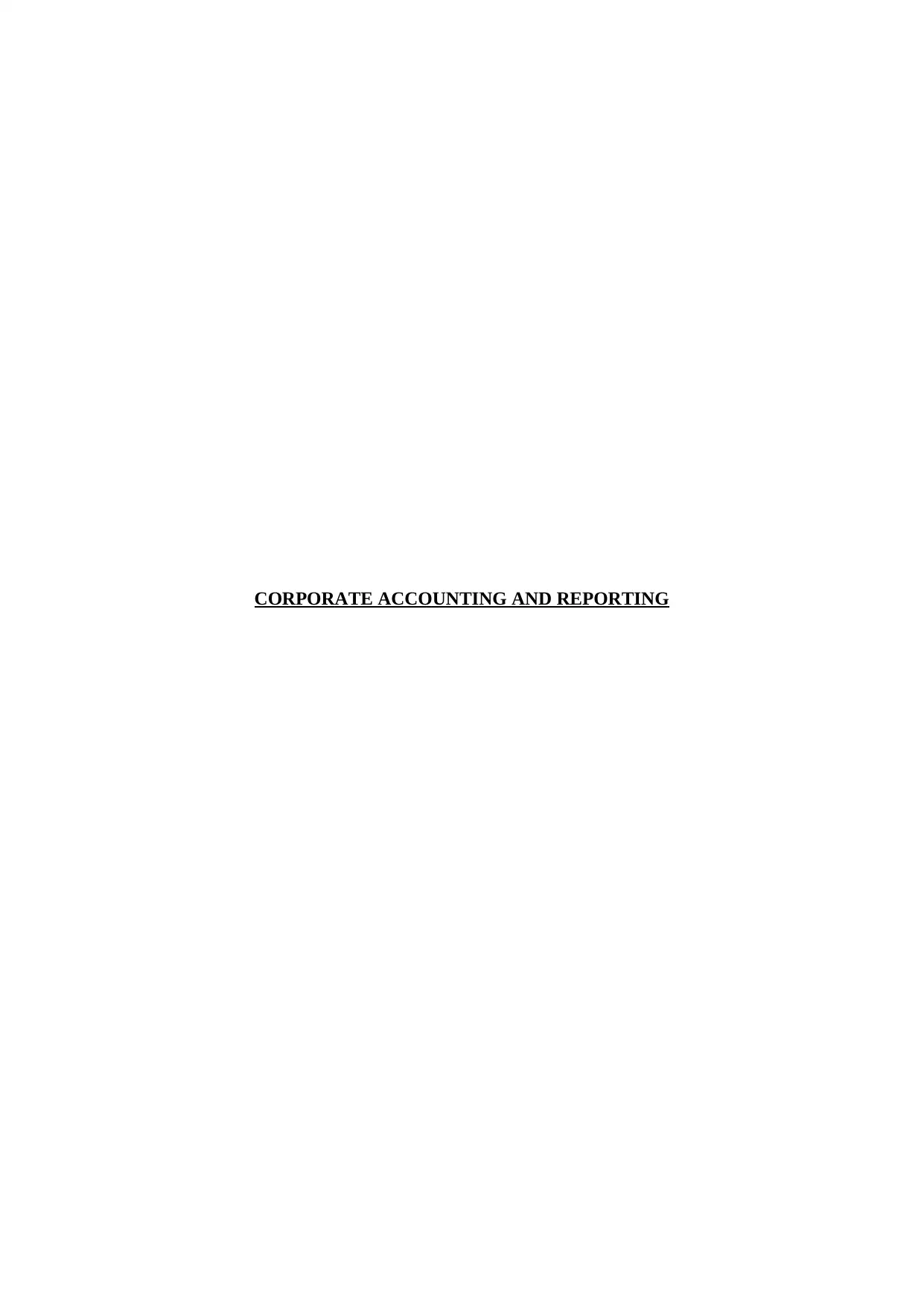
CORPORATE ACCOUNTING AND REPORTING
Paraphrase This Document
Need a fresh take? Get an instant paraphrase of this document with our AI Paraphraser
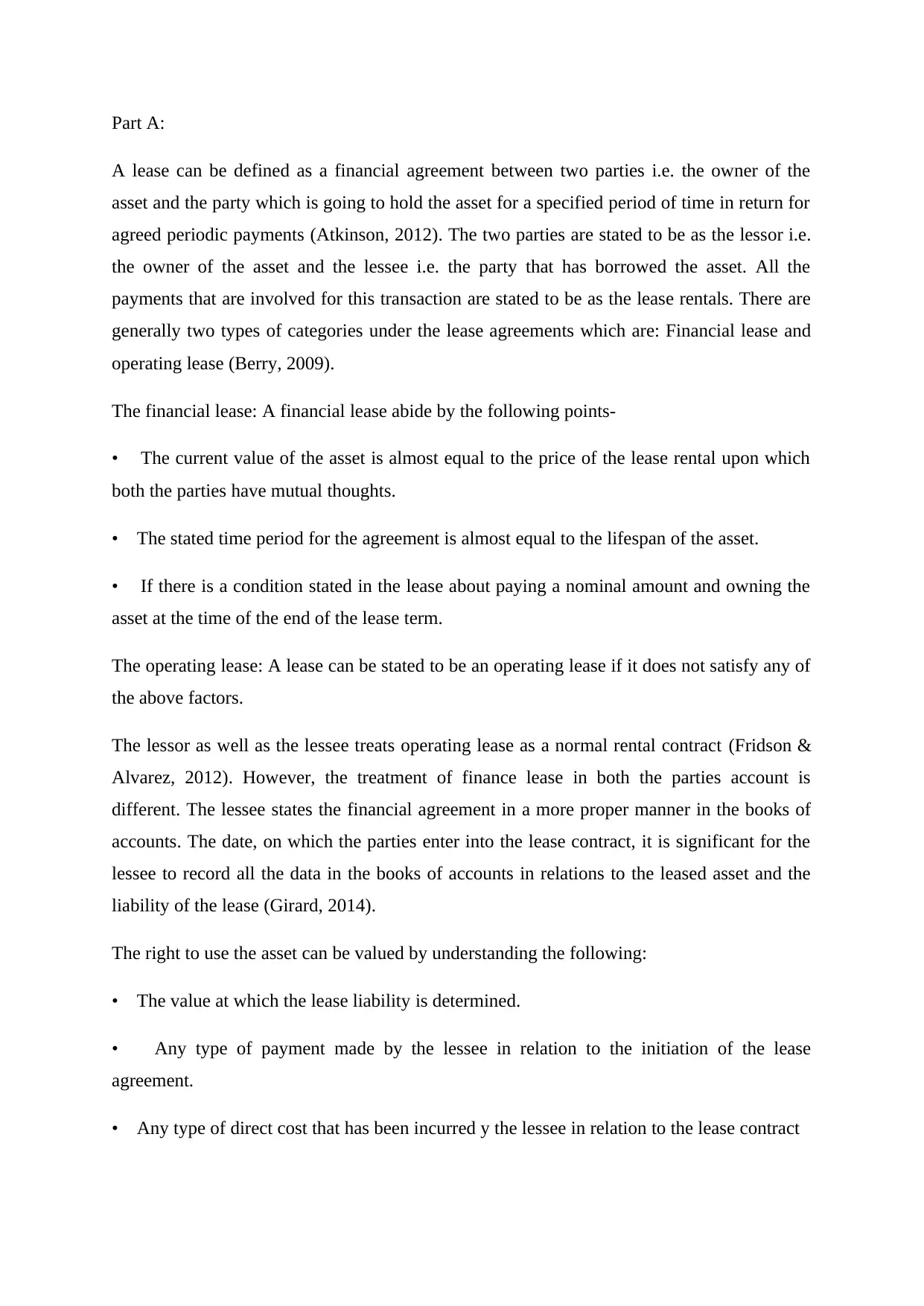
Part A:
A lease can be defined as a financial agreement between two parties i.e. the owner of the
asset and the party which is going to hold the asset for a specified period of time in return for
agreed periodic payments (Atkinson, 2012). The two parties are stated to be as the lessor i.e.
the owner of the asset and the lessee i.e. the party that has borrowed the asset. All the
payments that are involved for this transaction are stated to be as the lease rentals. There are
generally two types of categories under the lease agreements which are: Financial lease and
operating lease (Berry, 2009).
The financial lease: A financial lease abide by the following points-
• The current value of the asset is almost equal to the price of the lease rental upon which
both the parties have mutual thoughts.
• The stated time period for the agreement is almost equal to the lifespan of the asset.
• If there is a condition stated in the lease about paying a nominal amount and owning the
asset at the time of the end of the lease term.
The operating lease: A lease can be stated to be an operating lease if it does not satisfy any of
the above factors.
The lessor as well as the lessee treats operating lease as a normal rental contract (Fridson &
Alvarez, 2012). However, the treatment of finance lease in both the parties account is
different. The lessee states the financial agreement in a more proper manner in the books of
accounts. The date, on which the parties enter into the lease contract, it is significant for the
lessee to record all the data in the books of accounts in relations to the leased asset and the
liability of the lease (Girard, 2014).
The right to use the asset can be valued by understanding the following:
• The value at which the lease liability is determined.
• Any type of payment made by the lessee in relation to the initiation of the lease
agreement.
• Any type of direct cost that has been incurred y the lessee in relation to the lease contract
A lease can be defined as a financial agreement between two parties i.e. the owner of the
asset and the party which is going to hold the asset for a specified period of time in return for
agreed periodic payments (Atkinson, 2012). The two parties are stated to be as the lessor i.e.
the owner of the asset and the lessee i.e. the party that has borrowed the asset. All the
payments that are involved for this transaction are stated to be as the lease rentals. There are
generally two types of categories under the lease agreements which are: Financial lease and
operating lease (Berry, 2009).
The financial lease: A financial lease abide by the following points-
• The current value of the asset is almost equal to the price of the lease rental upon which
both the parties have mutual thoughts.
• The stated time period for the agreement is almost equal to the lifespan of the asset.
• If there is a condition stated in the lease about paying a nominal amount and owning the
asset at the time of the end of the lease term.
The operating lease: A lease can be stated to be an operating lease if it does not satisfy any of
the above factors.
The lessor as well as the lessee treats operating lease as a normal rental contract (Fridson &
Alvarez, 2012). However, the treatment of finance lease in both the parties account is
different. The lessee states the financial agreement in a more proper manner in the books of
accounts. The date, on which the parties enter into the lease contract, it is significant for the
lessee to record all the data in the books of accounts in relations to the leased asset and the
liability of the lease (Girard, 2014).
The right to use the asset can be valued by understanding the following:
• The value at which the lease liability is determined.
• Any type of payment made by the lessee in relation to the initiation of the lease
agreement.
• Any type of direct cost that has been incurred y the lessee in relation to the lease contract
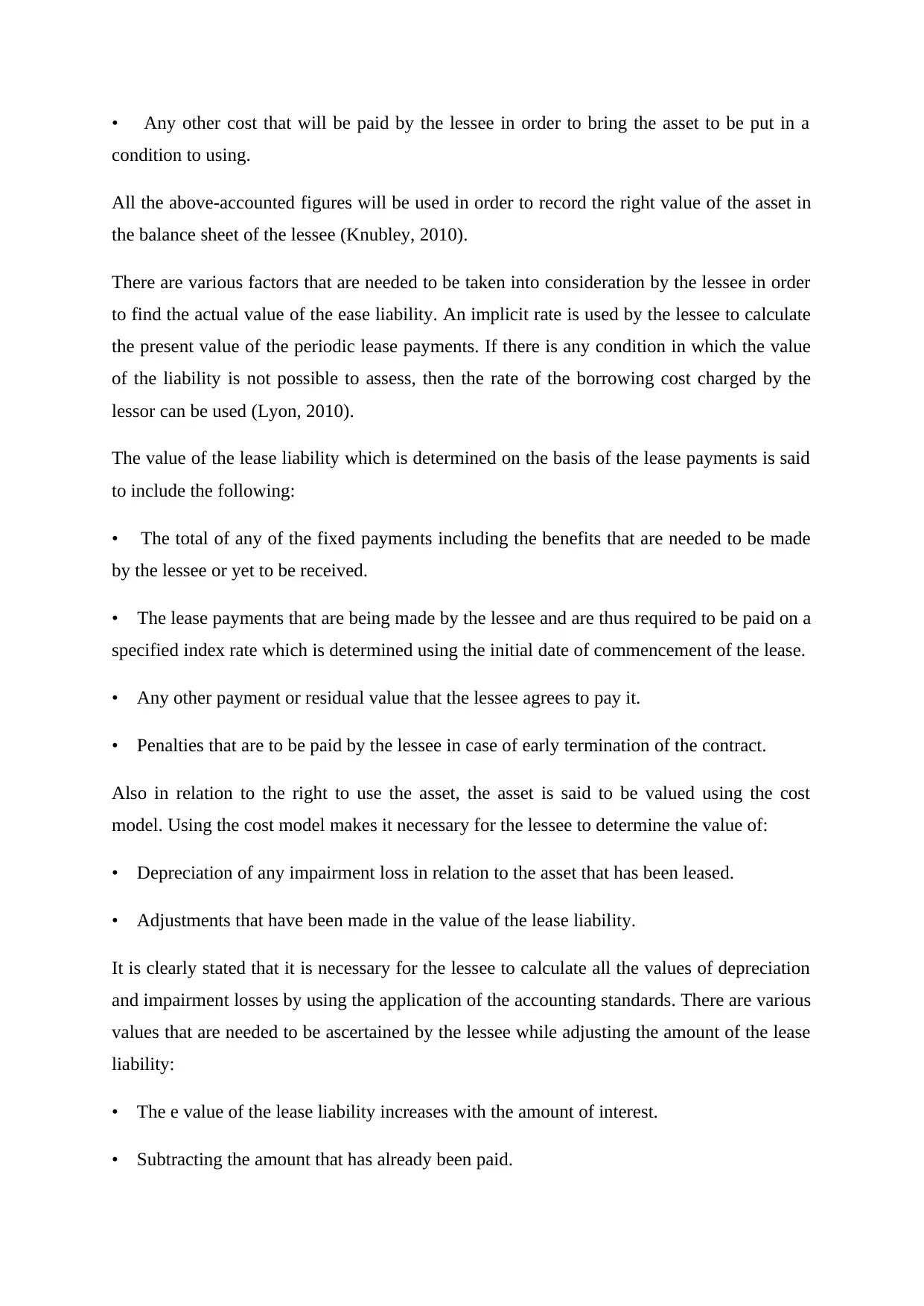
• Any other cost that will be paid by the lessee in order to bring the asset to be put in a
condition to using.
All the above-accounted figures will be used in order to record the right value of the asset in
the balance sheet of the lessee (Knubley, 2010).
There are various factors that are needed to be taken into consideration by the lessee in order
to find the actual value of the ease liability. An implicit rate is used by the lessee to calculate
the present value of the periodic lease payments. If there is any condition in which the value
of the liability is not possible to assess, then the rate of the borrowing cost charged by the
lessor can be used (Lyon, 2010).
The value of the lease liability which is determined on the basis of the lease payments is said
to include the following:
• The total of any of the fixed payments including the benefits that are needed to be made
by the lessee or yet to be received.
• The lease payments that are being made by the lessee and are thus required to be paid on a
specified index rate which is determined using the initial date of commencement of the lease.
• Any other payment or residual value that the lessee agrees to pay it.
• Penalties that are to be paid by the lessee in case of early termination of the contract.
Also in relation to the right to use the asset, the asset is said to be valued using the cost
model. Using the cost model makes it necessary for the lessee to determine the value of:
• Depreciation of any impairment loss in relation to the asset that has been leased.
• Adjustments that have been made in the value of the lease liability.
It is clearly stated that it is necessary for the lessee to calculate all the values of depreciation
and impairment losses by using the application of the accounting standards. There are various
values that are needed to be ascertained by the lessee while adjusting the amount of the lease
liability:
• The e value of the lease liability increases with the amount of interest.
• Subtracting the amount that has already been paid.
condition to using.
All the above-accounted figures will be used in order to record the right value of the asset in
the balance sheet of the lessee (Knubley, 2010).
There are various factors that are needed to be taken into consideration by the lessee in order
to find the actual value of the ease liability. An implicit rate is used by the lessee to calculate
the present value of the periodic lease payments. If there is any condition in which the value
of the liability is not possible to assess, then the rate of the borrowing cost charged by the
lessor can be used (Lyon, 2010).
The value of the lease liability which is determined on the basis of the lease payments is said
to include the following:
• The total of any of the fixed payments including the benefits that are needed to be made
by the lessee or yet to be received.
• The lease payments that are being made by the lessee and are thus required to be paid on a
specified index rate which is determined using the initial date of commencement of the lease.
• Any other payment or residual value that the lessee agrees to pay it.
• Penalties that are to be paid by the lessee in case of early termination of the contract.
Also in relation to the right to use the asset, the asset is said to be valued using the cost
model. Using the cost model makes it necessary for the lessee to determine the value of:
• Depreciation of any impairment loss in relation to the asset that has been leased.
• Adjustments that have been made in the value of the lease liability.
It is clearly stated that it is necessary for the lessee to calculate all the values of depreciation
and impairment losses by using the application of the accounting standards. There are various
values that are needed to be ascertained by the lessee while adjusting the amount of the lease
liability:
• The e value of the lease liability increases with the amount of interest.
• Subtracting the amount that has already been paid.
⊘ This is a preview!⊘
Do you want full access?
Subscribe today to unlock all pages.

Trusted by 1+ million students worldwide
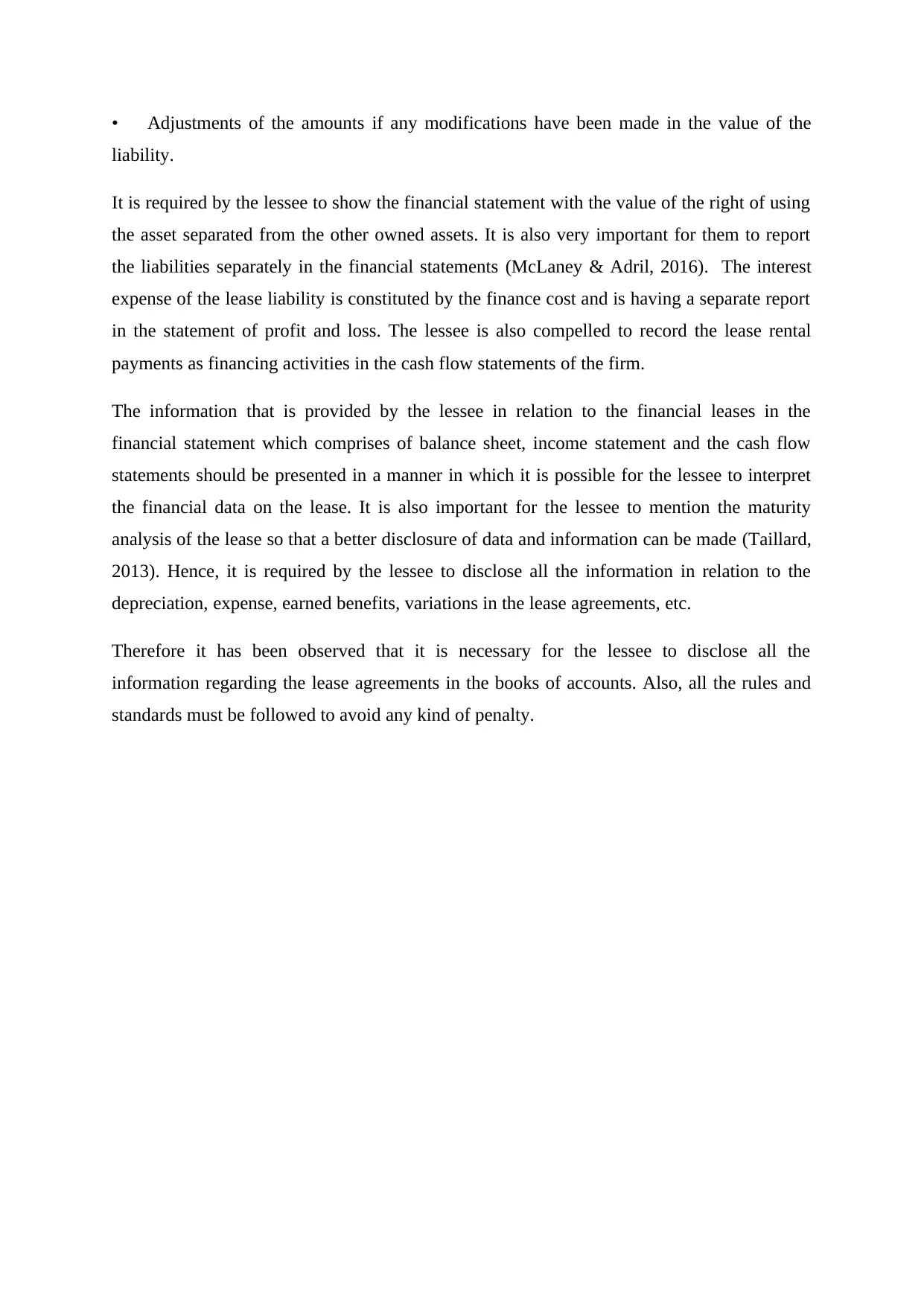
• Adjustments of the amounts if any modifications have been made in the value of the
liability.
It is required by the lessee to show the financial statement with the value of the right of using
the asset separated from the other owned assets. It is also very important for them to report
the liabilities separately in the financial statements (McLaney & Adril, 2016). The interest
expense of the lease liability is constituted by the finance cost and is having a separate report
in the statement of profit and loss. The lessee is also compelled to record the lease rental
payments as financing activities in the cash flow statements of the firm.
The information that is provided by the lessee in relation to the financial leases in the
financial statement which comprises of balance sheet, income statement and the cash flow
statements should be presented in a manner in which it is possible for the lessee to interpret
the financial data on the lease. It is also important for the lessee to mention the maturity
analysis of the lease so that a better disclosure of data and information can be made (Taillard,
2013). Hence, it is required by the lessee to disclose all the information in relation to the
depreciation, expense, earned benefits, variations in the lease agreements, etc.
Therefore it has been observed that it is necessary for the lessee to disclose all the
information regarding the lease agreements in the books of accounts. Also, all the rules and
standards must be followed to avoid any kind of penalty.
liability.
It is required by the lessee to show the financial statement with the value of the right of using
the asset separated from the other owned assets. It is also very important for them to report
the liabilities separately in the financial statements (McLaney & Adril, 2016). The interest
expense of the lease liability is constituted by the finance cost and is having a separate report
in the statement of profit and loss. The lessee is also compelled to record the lease rental
payments as financing activities in the cash flow statements of the firm.
The information that is provided by the lessee in relation to the financial leases in the
financial statement which comprises of balance sheet, income statement and the cash flow
statements should be presented in a manner in which it is possible for the lessee to interpret
the financial data on the lease. It is also important for the lessee to mention the maturity
analysis of the lease so that a better disclosure of data and information can be made (Taillard,
2013). Hence, it is required by the lessee to disclose all the information in relation to the
depreciation, expense, earned benefits, variations in the lease agreements, etc.
Therefore it has been observed that it is necessary for the lessee to disclose all the
information regarding the lease agreements in the books of accounts. Also, all the rules and
standards must be followed to avoid any kind of penalty.
Paraphrase This Document
Need a fresh take? Get an instant paraphrase of this document with our AI Paraphraser
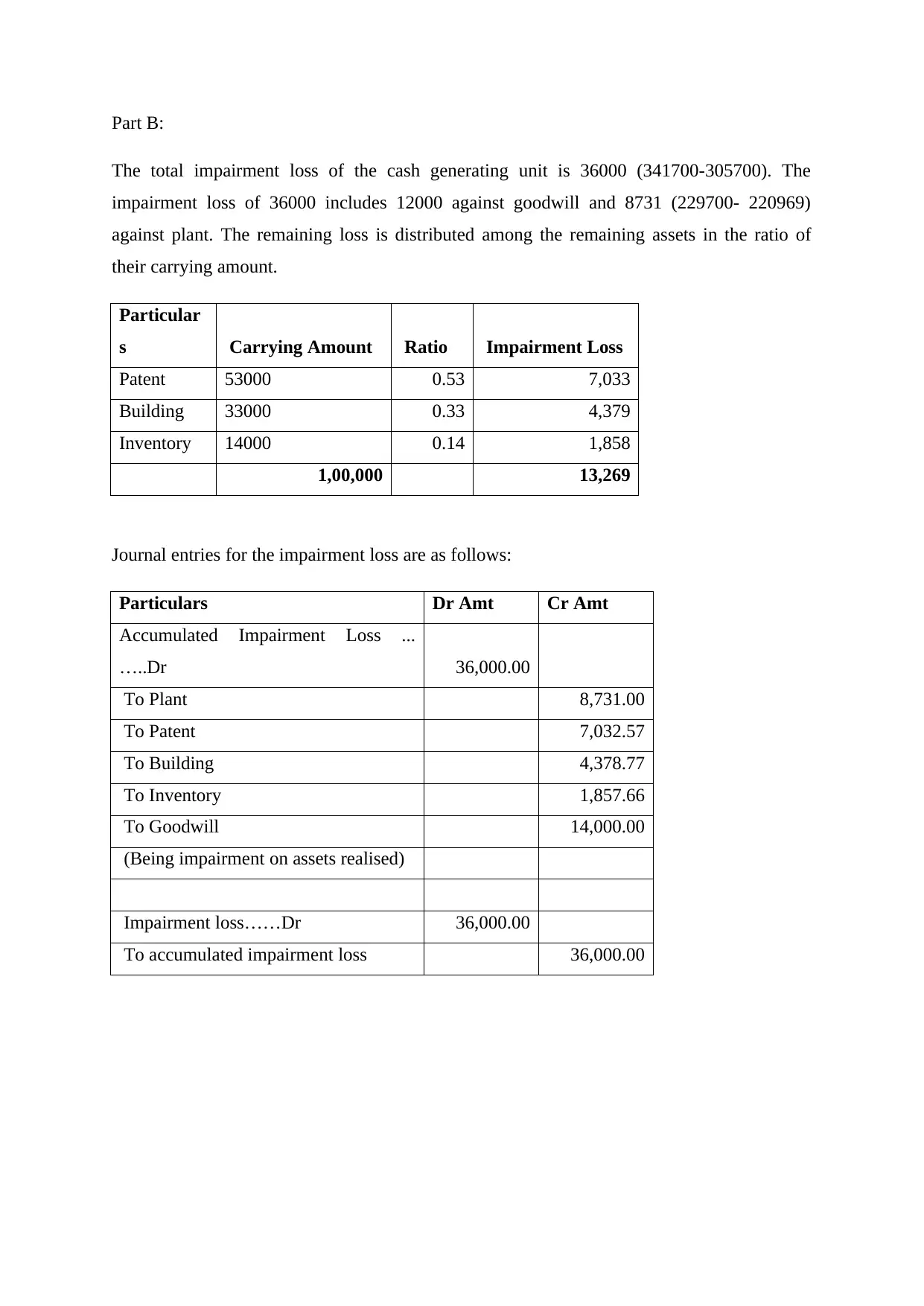
Part B:
The total impairment loss of the cash generating unit is 36000 (341700-305700). The
impairment loss of 36000 includes 12000 against goodwill and 8731 (229700- 220969)
against plant. The remaining loss is distributed among the remaining assets in the ratio of
their carrying amount.
Particular
s Carrying Amount Ratio Impairment Loss
Patent 53000 0.53 7,033
Building 33000 0.33 4,379
Inventory 14000 0.14 1,858
1,00,000 13,269
Journal entries for the impairment loss are as follows:
Particulars Dr Amt Cr Amt
Accumulated Impairment Loss ...
…..Dr 36,000.00
To Plant 8,731.00
To Patent 7,032.57
To Building 4,378.77
To Inventory 1,857.66
To Goodwill 14,000.00
(Being impairment on assets realised)
Impairment loss……Dr 36,000.00
To accumulated impairment loss 36,000.00
The total impairment loss of the cash generating unit is 36000 (341700-305700). The
impairment loss of 36000 includes 12000 against goodwill and 8731 (229700- 220969)
against plant. The remaining loss is distributed among the remaining assets in the ratio of
their carrying amount.
Particular
s Carrying Amount Ratio Impairment Loss
Patent 53000 0.53 7,033
Building 33000 0.33 4,379
Inventory 14000 0.14 1,858
1,00,000 13,269
Journal entries for the impairment loss are as follows:
Particulars Dr Amt Cr Amt
Accumulated Impairment Loss ...
…..Dr 36,000.00
To Plant 8,731.00
To Patent 7,032.57
To Building 4,378.77
To Inventory 1,857.66
To Goodwill 14,000.00
(Being impairment on assets realised)
Impairment loss……Dr 36,000.00
To accumulated impairment loss 36,000.00
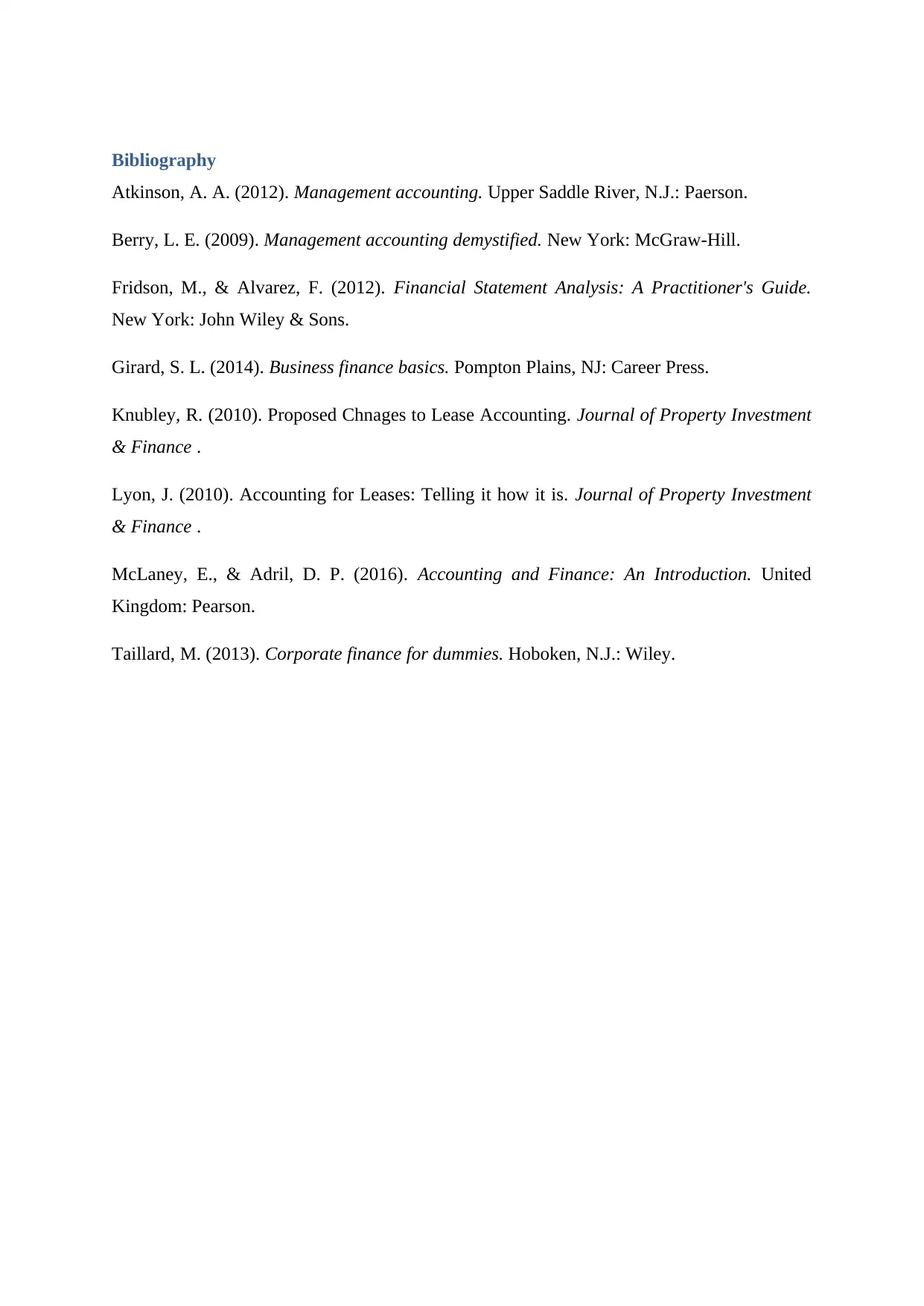
Bibliography
Atkinson, A. A. (2012). Management accounting. Upper Saddle River, N.J.: Paerson.
Berry, L. E. (2009). Management accounting demystified. New York: McGraw-Hill.
Fridson, M., & Alvarez, F. (2012). Financial Statement Analysis: A Practitioner's Guide.
New York: John Wiley & Sons.
Girard, S. L. (2014). Business finance basics. Pompton Plains, NJ: Career Press.
Knubley, R. (2010). Proposed Chnages to Lease Accounting. Journal of Property Investment
& Finance .
Lyon, J. (2010). Accounting for Leases: Telling it how it is. Journal of Property Investment
& Finance .
McLaney, E., & Adril, D. P. (2016). Accounting and Finance: An Introduction. United
Kingdom: Pearson.
Taillard, M. (2013). Corporate finance for dummies. Hoboken, N.J.: Wiley.
Atkinson, A. A. (2012). Management accounting. Upper Saddle River, N.J.: Paerson.
Berry, L. E. (2009). Management accounting demystified. New York: McGraw-Hill.
Fridson, M., & Alvarez, F. (2012). Financial Statement Analysis: A Practitioner's Guide.
New York: John Wiley & Sons.
Girard, S. L. (2014). Business finance basics. Pompton Plains, NJ: Career Press.
Knubley, R. (2010). Proposed Chnages to Lease Accounting. Journal of Property Investment
& Finance .
Lyon, J. (2010). Accounting for Leases: Telling it how it is. Journal of Property Investment
& Finance .
McLaney, E., & Adril, D. P. (2016). Accounting and Finance: An Introduction. United
Kingdom: Pearson.
Taillard, M. (2013). Corporate finance for dummies. Hoboken, N.J.: Wiley.
⊘ This is a preview!⊘
Do you want full access?
Subscribe today to unlock all pages.

Trusted by 1+ million students worldwide
1 out of 6
Related Documents
Your All-in-One AI-Powered Toolkit for Academic Success.
+13062052269
info@desklib.com
Available 24*7 on WhatsApp / Email
![[object Object]](/_next/static/media/star-bottom.7253800d.svg)
Unlock your academic potential
Copyright © 2020–2025 A2Z Services. All Rights Reserved. Developed and managed by ZUCOL.





